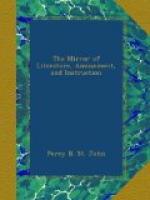The city itself is surrounded by walls, built of freestone, with alternate layers of Roman brick, flanked by 478 towers; the walls, however, are in several places so dilapidated as to be incapable of any defence without great reparation. On the land side, the fortifications consist of a triple wall, with towers at every 150 yards; the first wall being 30 feet in height; the second 20, and about 30 feet from the first; the third is twelve feet in height; beyond this is a fosse, thirty feet wide, now converted into gardens, and filled with fine grown trees, and a low counterscarp. There are five gates on this side, and several to the water. The streets, of which there are 3,770, with the exception of two or three, are narrow, irregular, badly paved, and exceedingly dirty, the only scavengers being vultures and half-starved dogs. There are fourteen imperial mosques, about 200 others, and above that number of messjids or chapels. The number of houses is prodigious; in 1796, the register of Effendissy gave 88,185 within the walls; they are mostly constructed of wood, and the dwellings of the lower classes are mere wooden boxes, cool in summer, the windows being unglazed, and in winter heated by pans of charcoal. Fires are consequently very frequent. The khans, or warehouses of the merchants are, however, fireproof; the bazaars are also defended from fire, and are well built; and coffeehouses very numerous. The city is amply supplied with water, there being 730 public baths, a superb fountain in the Chinese taste in every street, and few houses without similar provision. The population of the city and suburbs is estimated at upwards of 600,000; of these above one half are Turks, the remainder Jews, Franks, Greeks, &c.
We have only space to particularize a few of the most prominent buildings in our view. To the left is the Seraglio Point, or superb palace of the Sultan, whose treasures almost realize the fables of romance. Next is the superb dome of the Mosque of the Sultan Achmet, without exception the finest building ever raised by the Turks. It is surrounded by a lofty colonnade of marble, of various colours, surmounted by 30 small domes: the large dome is supported by four gigantic piers, covered as well as most of the interior, with fresco paintings; it is rich in columns of verd antique, Egyptian granite, and white marble; there are also four smaller domes, similarly ornamented. Next, near the centre of the Engraving is the Mosque of Santa Sophia, a truly superb and perfect monument of antiquity, built at an expense of 320,000 pounds of silver, (some authors say gold.[2]) Next in importance are the Mosques of the Sultans Osmyn, Bajazet, and Selim; and the Gulf of the Golden Horn, or the Harbour.




